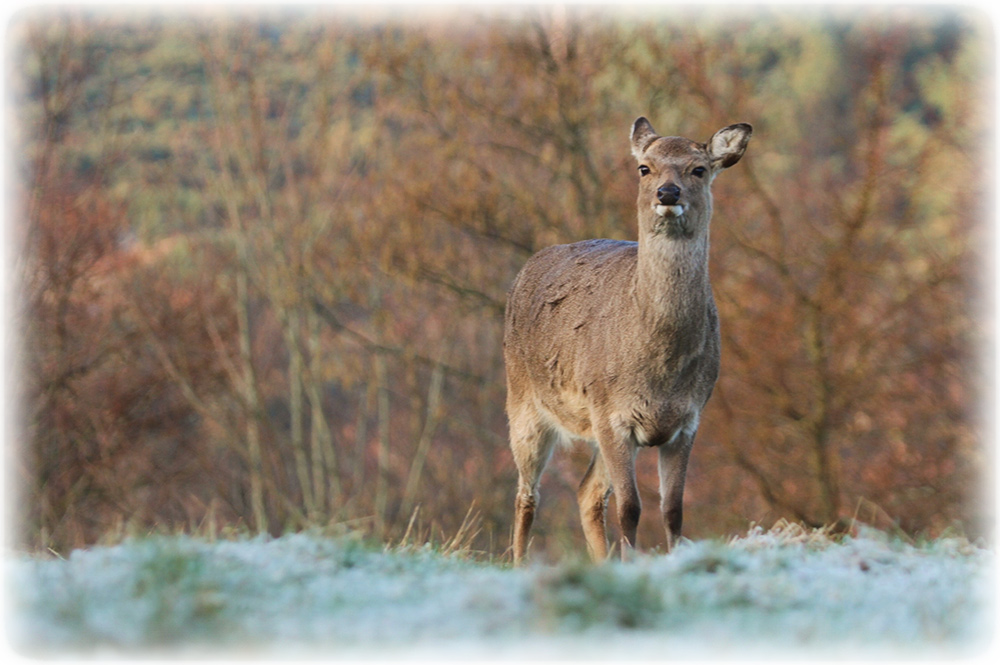
Introduction
A sound knowledge of deer behaviour is essential for the efficient management of deer.
This guide describes features of deer behaviour which are more or less common to Irish deer species (see Species guides for behaviour specific to each), but each species is different, deer are very adaptable, and their behaviour can vary widely with habitat, deer density, and human disturbance.
This guide links to: Deer Species, Deer Signs and Deer Biology guides.
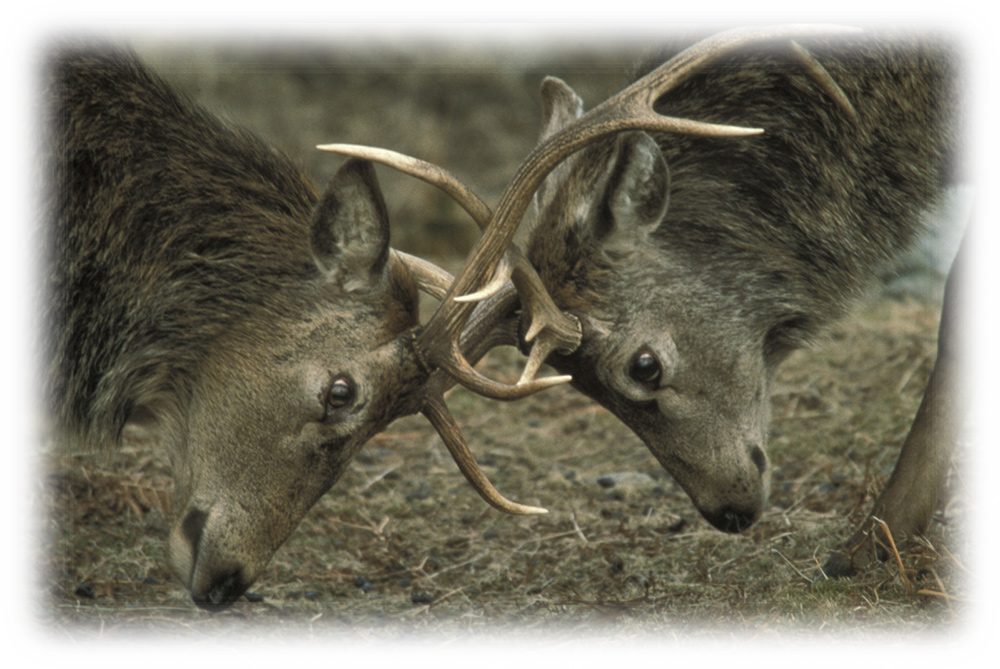
Habitats
Deer are usually found in or near to forest/woodland/scrub and frequently feed on grass or arable land near to cover. Some species are content to live on open areas of heath or moorland. Deer are very adaptable and may be seen in peri-urban or urban situations or other places where there is cover and a food source, they can have marked preferences for different habitats according to deer species, habitat type, the time of year or weather conditions.
Social structure
Deer may form herds or act in a more solitary manner according to species, age and sex.
Solitary deer tend to be territorial, especially the males. Herding animals are more inclined to form groups, members of a herd may often be closely related.
Herds or individuals tend to be “hefted” to an area in which they prefer to live, this tendency is strongest in territorial deer and females of the herding species. The herding deer may have “core areas” sometimes several miles apart, using these at various times of year but rarely being seen on the intervening land.
It may sometimes be possible to identify the home range of a herd, group or individual by sightings and the signs that they leave behind (Deer Signs guide).
The relationship of young deer with adults varies with species, see Table 2.
Where different species live in the same area, they generally live separate lives but there may be passive competition for resources and possibly a degree of aggression.
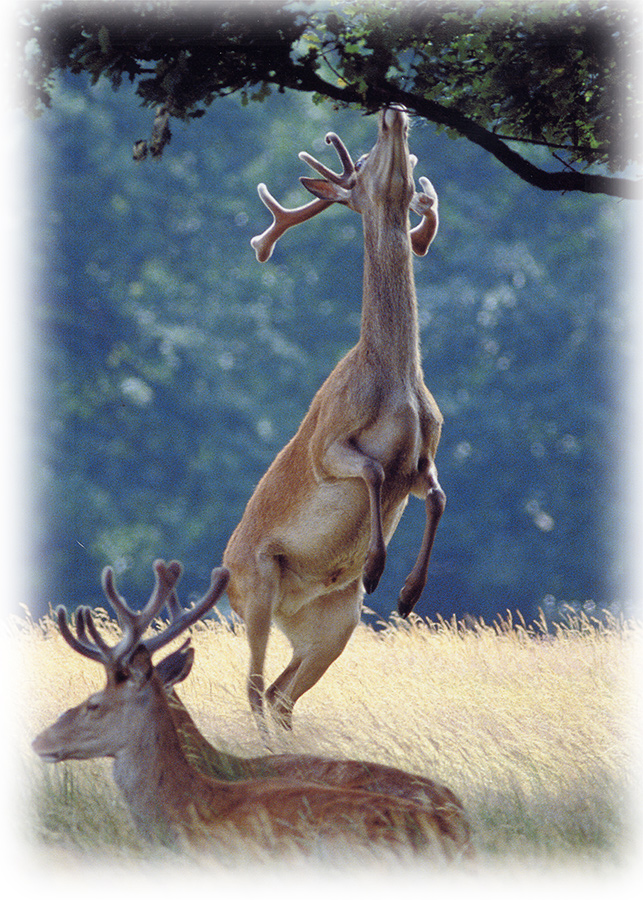
Response to disturbance
Deer are relatively shy animals which may give the impression that there are fewer around than there actually are. They are alert to danger and will respond quickly, usually by running away and/or seeking cover but sometimes lying up in or running into wide open areas where they can assess threats. Deer can be easy to stress but recover quickly when the threat is removed. One common response to
persistent disturbance is for deer to change their behaviour, e.g. by avoiding busy times/places or becoming nocturnal. This plasticity of behaviour must be taken into account when planning deer management.
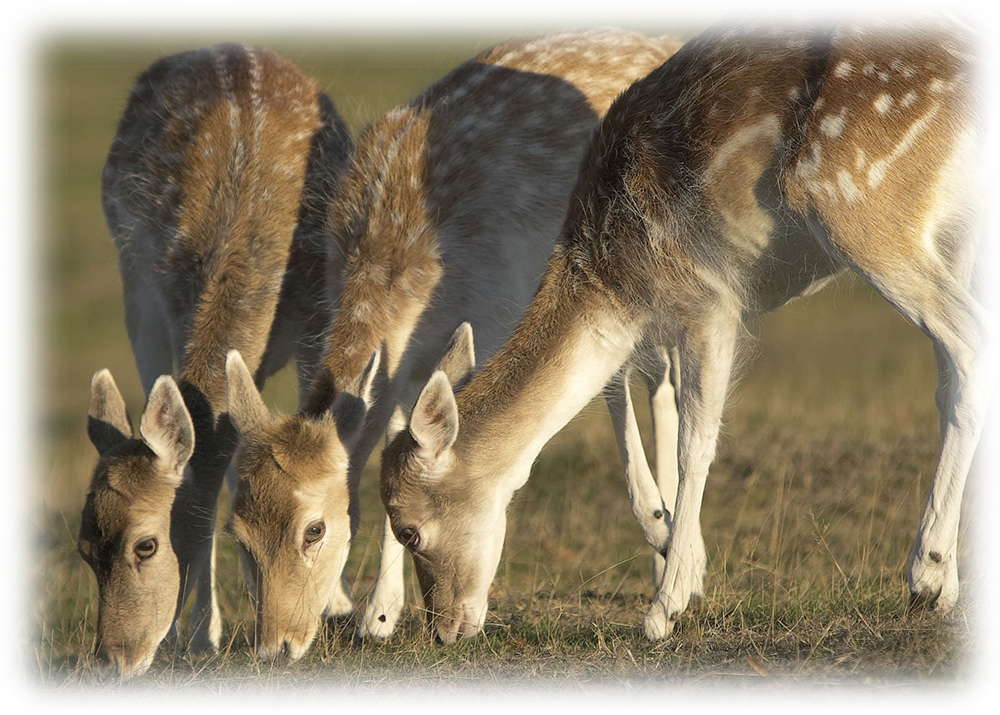
Feeding
Deer have evolved as prey animals and prefer to spend their time in cover or where they feel secure. With a large rumen( see Deer Biology) they can ingest large quantities of bulky plant food then return to safe areas to lie down (couch) and ruminate(chew the cud). For most species this means that when undisturbed they tend to feed and couch on a 2-4 hourly cycle. Often though, the majority of movement will be at dawn and dusk and sometimes at night.
Deer graze and browse, that is, taking ground-level plants, as well as food from higher shrubby plants and trees. Each species has its own preferences which may vary according to habitat, some are especially selective in their feeding habits. Feeding deer can come into conflict with human interests, in some cases damage by deer to sensitive habitats, crops and even gardens can be serious.
In woodlands, deer at the right density can be of benefit but at high density over a long period they can eat all palatable woodland plants within reach and are forced to range further from woodland to feed. This can bring them into conflict with surrounding landowners and may cause an increase in road accidents. The flora and structure of woodlands can be changed markedly by high deer numbers and such changes may be damaging and long term.
Breeding
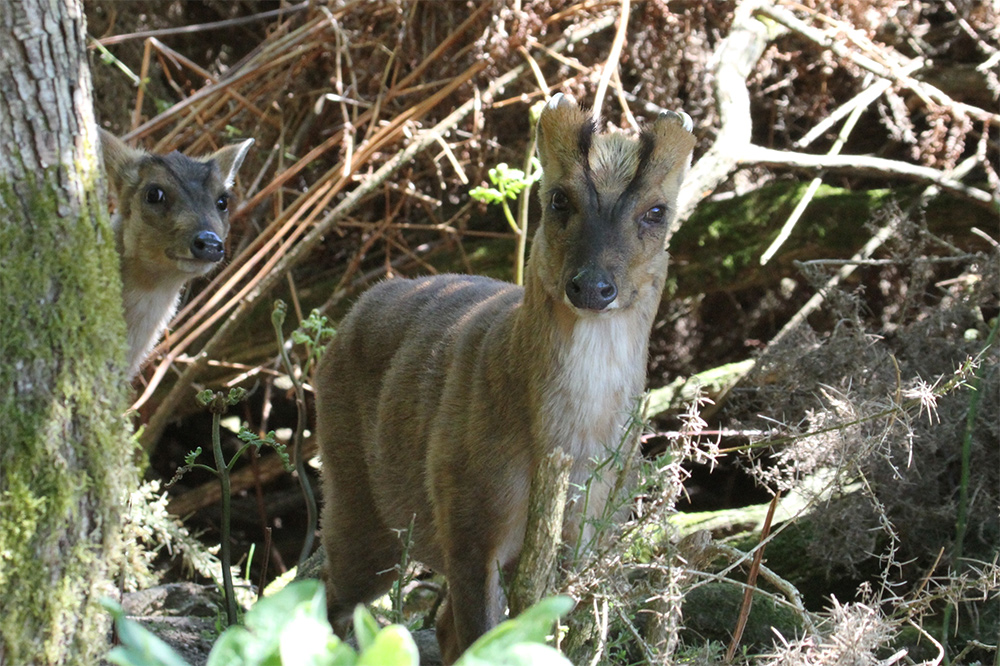
With the exception of Muntjac, which breed all year round, most deer have an annual mating period (“rut”) which varies in timing with species. Around the rut males become more aggressive (sometimes also less timid towards people) and tend to move more outside of their normal range making them unpredictable and more vulnerable to traffic accidents. The larger species may have traditional rutting areas which temporarily become very busy until the rut ends.
Females of herding species often leave the herd to have their young, returning only when the young are strong enough to run with the herd.
For the first few days of life young deer are often left hidden in cover for hours, during which time their mother feeds, then returns to suckle them, this can lead to well-intentioned humans picking them up and disturbing a perfectly natural situation. The best advice is to return the young deer as soon as possible to where it was found, usually its mother will reclaim it. Young deer can be vulnerable when hidden in silage and hay meadows which are due to be cut.
Aggression
Deer of both sexes can be surprisingly aggressive to each other, this aggression is usually linked to status within the herd or local population and/or competition for food, space and breeding status. Aggression usually takes the form of barging, kicking (sometimes boxing while standing on their hind legs), biting and more subtle facial or vocal expressions.
When antlered males clash the initial stages may be ritualised but fights usually result in the clashing of antlers and strenuous head to head shoving match, the winner is usually the strongest, not necessarily the one with the largest antlers. Species such as red deer maintain a more or less linear hierarchy where each animal knows its place above and below the next. The usual reaction to humans, dogs or predators is to run, if possible to cover, although cornered deer, males in the rut, or females with young can be very aggressive if threatened. Hand reared deer of both sexes can be very dangerous.
Vocalisation
Deer are generally quiet but most have specific alarm calls, calls between mother and young and male calls during the rut, some have female calls when seeking a mate or giving birth.
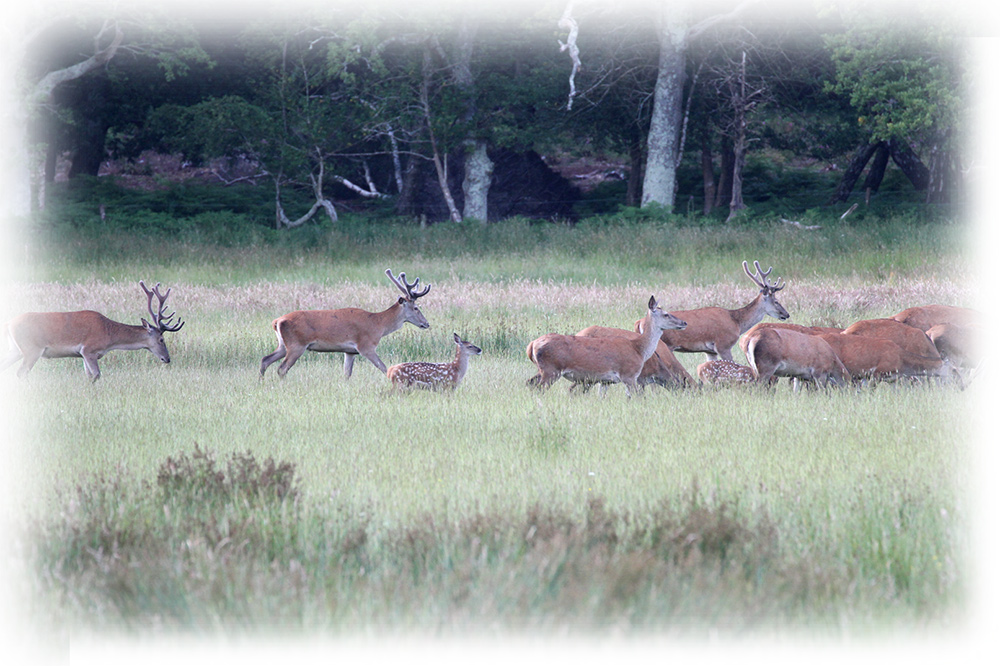
deer often move at dawn and dusk
Patterns of activity
Deer tend to use well-trodden paths known as racks to move within cover and to and from feeding places. Using these and other deer signs it is usually possible to build up a picture of how deer use a habitat.
Patterns of activity |
|
| Seasonal | Deer tend to move more and thus be more visible at certain times of the year such as when establishing territories, during the rut, when females are heavily pregnant and when food is scarce. Deer may also be less obvious at times such as when females have newly born young, males post rut or all deer in harsh weather. The males and females of larger deer ( Red, Fallow, Sika) may spend most of their year in segregated herds, the males moving into female areas only during the rut or sheltering with them in harsh weather. |
| Time of day | Deer tend to move more at dawn and dusk but can be active at any time of day or night. Older animals tend to be more cautious and may move later in the evening and retreat to cover earlier in the morning than younger ones |
| Wind | Deer can be sensitive to cold winds and during these conditions may prefer not to come into the open or to feed on the sheltered side of woodlands or hills. In woodland long, straight rides may act as wind tunnels, discouraging feeding deer when it is windy. |
| Rain and snow | Prior to heavy rain or snowfall deer often have a burst of feeding activity. They will seek shelter from heavy rain but will emerge if rain persists for days. After heavy snow deer may lay up for a day or two, thereafter activity increases and they tend to move up onto moorland/heathland, hilltops, windblown banks and the side of forestry tracks where snow is thinner. If the sun appears following periods of heavy rain or during a thaw deer tend to move out in the open to avoid dripping trees. |
| Heat/cold | In very hot periods deer may be less active, generally restricting their movements to dawn, dusk and night. In the early mornings deer may often be found on east facing wood or field margins enjoying the first rays of sunlight. During periods of hard frosts deer lay up and feed in areas benefiting from the sun’s heat, this frequently results in increased movement during the warmest parts of the day. |
| Moon | Deer tend to move more under bright moonlight than on darker nights. |
| Disturbance | Deer tend to seek cover when disturbed. If continually harassed they may become extremely shy, become nocturnal or leave the area altogether. |
Behavioural comparison
| Species | Habitat and feeding | Breeding | Young/ Adult relationship | Social structure and Home range | Response to disturbance |
| Red Fallow Sika | Woodland, farmland, scrub, heath or moor. Predominantly grazers but also selective browsers. | Annual rut in autumn. Usually have single young. Males and females often live separately except during rut. Males may range widely during rut becoming more prone to road collisions. | Young stay with dam for at least 1 year. Females remain with hind herd for life, males join adult male herd as juveniles. | Form herds. Sexes separate for most of year and may behave quite differently. Male dominance tends to be hierarchical and is most intense in the rut. Female herds often led by a dominant “matriarch”. May be “hefted” and/or range over many miles between “core areas” Often lay up and feed in areas some distance apart. May lay up in open areas during day. If the population increases herds get bigger but stay in much the same area increasing impacts, eventually, and often triggered by an event such as harsh weather or intense disturbance, groups might splinter off into formerly unoccupied areas to form new herds. If herd leaders are culled or if there is intense culling pressure on a landscape scale this may lead to herds coalescing into very large groups. Cross boundary cooperation for management is very important. | Move as a herd. May leave area entirely but then return, unpredictably. Easily pushed into nocturnal behaviour. |
| Muntjac | Woodland, farmland, scrub. Adapts easily to peri-urban areas. Highly selective browsers but also graze. Fond of flowering plants. | Breeds all year. One fawn every 7 months. No close season. | Young stay with dam until just before birth of next young, they are then largely independent. | Solitary or family groups. Males and females live in same area all year. Males and sometimes females hold territories. Males can be intensely aggressive to other males for much of the year. Strongly “hefted” to home range which may be less than 1 square kilometer. Usually feed within a few hundred metres of lying up areas. Population increase tends to lead to emigration and colonisation of unoccupied areas if available, if not, displaced animals find marginal areas or try to co-exist with territory holders. If a home range or territory becomes vacant there is often rapid infill by other animals.. | Seek cover, will often circle around threat, sometimes barking. Usually remain in area but keep out of sight. May become nocturnal if daytime disturbance is continuous. |
Further Info
Mayle, B.A. (1999) Managing Deer in the Countryside. Forest Research Practice Note.
Prior,R. (2007) Deer Watch – A Field Guide. Swan Hill Press.
Harris, S. and Yalden, D.W. eds. (2008) Mammals of the British Isles. 4th ed. Mammal Society
[printfriendly]